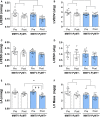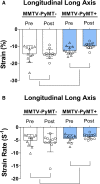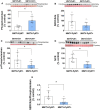Breast Cancer Promotes Cardiac Dysfunction Through Deregulation of Cardiomyocyte Ca2+-Handling Protein Expression That is Not Reversed by Exercise Training
- PMID: 33619982
- PMCID: PMC8174298
- DOI: 10.1161/JAHA.120.018076
Breast Cancer Promotes Cardiac Dysfunction Through Deregulation of Cardiomyocyte Ca2+-Handling Protein Expression That is Not Reversed by Exercise Training
Abstract
Background Patients treated for breast cancer have a high incidence of cardiovascular complications. In this study, we evaluated the impact of breast cancer on cardiac function and cardiomyocyte Ca2+-handling protein expression. We also investigated whether exercise training (ET) would prevent these potential alterations. Methods and Results Transgenic mice with spontaneous breast cancer (mouse mammary tumor virus-polyomavirus middle T antigen [MMTV-PyMT+], n=15) and littermate mice with no cancer (MMTV-PyMT-, n=14) were studied. For the ET analysis, MMTV-PyMT+ were divided into sedentary (n=10) and exercise-trained (n=12) groups. Cardiac function was evaluated by echocardiography with speckle-tracking imaging. Exercise tolerance test was conducted on a treadmill. Both studies were performed when the tumor became palpable and when it reached 1 cm3. After euthanasia, Ca2+-handling protein expression (Western blot) was evaluated. Exercise capacity was reduced in MMTV-PyMT+ compared with MMTV-PyMT- (Pinteraction=0.031). Longitudinal strain (Pgroup <0.001) and strain rate (Pgroup=0.030) were impaired. Cardiomyocyte phospholamban was increased (P=0.011), whereas phospho-phospholamban and sodium/calcium exchanger were decreased (P=0.038 and P=0.017, respectively) in MMTV-PyMT+. No significant difference in sarcoplasmic or endoplasmic reticulum calcium 2 ATPase (SERCA2a) was found. SERCA2a/phospholamban ratio was reduced (P=0.007). ET was not associated with increased exercise capacity. ET decreased left ventricular end-systolic diameter (Pgroup=0.038) and end-diastolic volume (Pgroup=0.026). Other morphological and functional cardiac parameters were not improved by ET in MMTV-PyMT+. ET did not improve cardiomyocyte Ca2+-handling protein expression. Conclusions Breast cancer is associated with decreased exercise capacity and subclinical left ventricular dysfunction in MMTV-PyMT+, which is at least partly associated with dysregulation of cardiomyocyte Ca2+ handling. ET did not prevent or reverse these changes.
Keywords: Ca2+ handling; breast cancer; cardiac function.
Conflict of interest statement
None.
Figures




Similar articles
-
Cardioprotection of voluntary exercise against breast cancer-induced cardiac injury via STAT3.Basic Res Cardiol. 2025 Feb;120(1):113-131. doi: 10.1007/s00395-024-01076-8. Epub 2024 Aug 19. Basic Res Cardiol. 2025. PMID: 39158697
-
Exercise training improves the net balance of cardiac Ca2+ handling protein expression in heart failure.Physiol Genomics. 2007 May 11;29(3):246-52. doi: 10.1152/physiolgenomics.00188.2006. Epub 2007 Jan 23. Physiol Genomics. 2007. PMID: 17244791
-
Exercise training reverses myocardial dysfunction induced by CaMKIIδC overexpression by restoring Ca2+ homeostasis.J Appl Physiol (1985). 2016 Jul 1;121(1):212-20. doi: 10.1152/japplphysiol.00188.2016. Epub 2016 May 26. J Appl Physiol (1985). 2016. PMID: 27231311 Free PMC article.
-
Exercise training delays cardiac dysfunction and prevents calcium handling abnormalities in sympathetic hyperactivity-induced heart failure mice.J Appl Physiol (1985). 2008 Jan;104(1):103-9. doi: 10.1152/japplphysiol.00493.2007. Epub 2007 Nov 1. J Appl Physiol (1985). 2008. PMID: 17975126
-
Digoxin Combined with Aerobic Interval Training Improved Cardiomyocyte Contractility.Int J Sports Med. 2021 Jun;42(8):694-702. doi: 10.1055/a-1300-2583. Epub 2020 Dec 15. Int J Sports Med. 2021. PMID: 33321522
Cited by
-
Exercise Training Preserves Myocardial Strain and Improves Exercise Tolerance in Doxorubicin-Induced Cardiotoxicity.Front Cardiovasc Med. 2021 Apr 1;8:605993. doi: 10.3389/fcvm.2021.605993. eCollection 2021. Front Cardiovasc Med. 2021. PMID: 33869297 Free PMC article.
-
Inter-organ communication: pathways and targets to cardioprotection and neuro-protection. A report from the 12th Hatter Cardiovascular Institute workshop.Basic Res Cardiol. 2025 Apr;120(2):287-299. doi: 10.1007/s00395-024-01094-6. Epub 2024 Dec 16. Basic Res Cardiol. 2025. PMID: 39681732 Free PMC article.
-
Cardioprotection of voluntary exercise against breast cancer-induced cardiac injury via STAT3.Basic Res Cardiol. 2025 Feb;120(1):113-131. doi: 10.1007/s00395-024-01076-8. Epub 2024 Aug 19. Basic Res Cardiol. 2025. PMID: 39158697
-
Effect of Exercise on Breast Cancer: A Systematic Review and Meta-analysis of Animal Experiments.Front Mol Biosci. 2022 Jun 6;9:843810. doi: 10.3389/fmolb.2022.843810. eCollection 2022. Front Mol Biosci. 2022. PMID: 35733941 Free PMC article. Review.
-
Exosomal transfer of pro-pyroptotic miR-216a-5p exacerbates anthracycline cardiotoxicity through breast cancer-heart pathological crosstalk.Signal Transduct Target Ther. 2025 May 14;10(1):157. doi: 10.1038/s41392-025-02245-4. Signal Transduct Target Ther. 2025. PMID: 40360476 Free PMC article.
References
-
- GLOBOCAN 2020: new global cancer data|UICC. Available at: https://www.uicc.org/news/globocan‐2020‐new‐global‐cancer‐data. Accessed January 13, 2021.
Publication types
MeSH terms
Substances
LinkOut - more resources
Full Text Sources
Other Literature Sources
Medical
Miscellaneous

